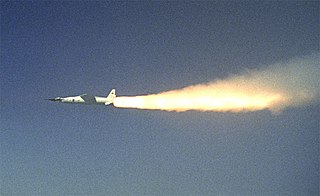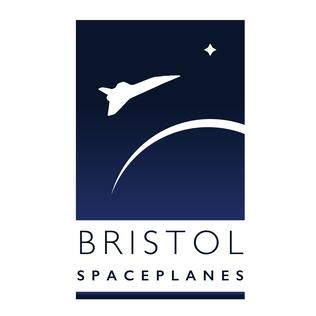
A scramjet is a variant of a ramjet airbreathing jet engine in which combustion takes place in supersonic airflow. As in ramjets, a scramjet relies on high vehicle speed to compress the incoming air forcefully before combustion, but whereas a ramjet decelerates the air to subsonic velocities before combustion, the airflow in a scramjet is supersonic throughout the entire engine. That allows the scramjet to operate efficiently at extremely high speeds.

A spaceplane is an aerospace vehicle that operates as an aircraft in Earth's atmosphere, as well as a spacecraft when it is in space. It combines features of an aircraft and a spacecraft, which can be thought of as an aircraft that can endure and maneuver in the vacuum of space or likewise a spacecraft that can fly like an airplane. Typically, it takes the form of a spacecraft equipped with wings, although lifting bodies have been designed and tested as well. The propulsion to reach space may be purely rocket based or may use the assistance of airbreathing jet engines. The spaceflight is then followed by an unpowered glide return to landing.

The X-43 was an experimental unmanned hypersonic aircraft with multiple planned scale variations meant to test various aspects of hypersonic flight. It was part of the X-plane series and specifically of NASA's Hyper-X program. It set several airspeed records for jet aircraft. The X-43 is the fastest aircraft on record at approximately Mach 9.6.

The Pegasus is an air-launched rocket developed by Orbital Sciences Corporation. Capable of carrying small payloads of up to 443 kilograms (977 lb) into low Earth orbit, Pegasus first flew in 1990 and remains active as of 2018. The vehicle consists of three solid propellant stages and an optional monopropellant fourth stage. Pegasus is released from its carrier aircraft at approximately 40,000 ft (12,000 m), and its first stage has a wing and a tail to provide lift and attitude control while in the atmosphere.

The Falcon 1 was an expendable launch system privately developed and manufactured by SpaceX during 2006–2009. On 28 September 2008, Falcon 1 became the first privately-developed liquid-fuel launch vehicle to go into orbit around the Earth.

Air launching is the practice of releasing a rocket, missile, parasite aircraft or other aircraft payload from a mother ship or launch aircraft. The payload craft or missile is often tucked under the wing of the larger mother ship and then "dropped" while in flight. It may also be stored within a bomb bay, beneath the main fuselage or even on the back of the carrier aircraft, as in the case of the D-21 drone. Air launching provides several advantages over ground launching, giving the smaller craft an altitude and range boost, while saving it the weight of the fuel and equipment needed to take off on its own.

A launch vehicle or carrier rocket is a rocket used to carry a payload from Earth's surface through outer space, either to another surface point, or into space. A launch system includes the launch vehicle, launch pad, vehicle assembly and fuelling systems, range safety, and other related infrastructure.

Long March 5 is a Chinese heavy lift launch system developed by China Academy of Launch Vehicle Technology (CALT). CZ-5 is the first Chinese vehicle with a new design focusing on liquid rocket propellants from the ground up. Currently, two CZ-5 vehicle configurations are planned for different missions, with a maximum payload capacity of ~25,000 kilograms (55,000 lb) to LEO and ~14,000 kilograms (31,000 lb) to GTO. The Long March 5 roughly matches the capabilities of American EELV heavy-class vehicles such as the Delta IV Heavy.

The Boeing X-51 Waverider is an unmanned research scramjet experimental aircraft for hypersonic flight at Mach 5 and an altitude of 70,000 feet (21,000 m). The aircraft was designated X-51 in 2005. It completed its first powered hypersonic flight on 26 May 2010. After two unsuccessful test flights, the X-51 completed a flight of over six minutes and reached speeds of over Mach 5 for 210 seconds on 1 May 2013 for the longest duration powered hypersonic flight.
Scramjet programs refers to research and testing programs for the development of supersonic combustion ramjets, known as scramjets. This list provides a short overview of national and international collaborations, and civilian and military programs. The USA, Russia, India, and China (2014), have succeeded at developing scramjet technologies.

Vertical takeoff, vertical landing (VTVL) is a form of takeoff and landing for rockets. Multiple VTVL craft have flown.
A gravity turn or zero-lift turn is a maneuver used in launching a spacecraft into, or descending from, an orbit around a celestial body such as a planet or a moon. It is a trajectory optimization that uses gravity to steer the vehicle onto its desired trajectory. It offers two main advantages over a trajectory controlled solely through the vehicle's own thrust. First, the thrust is not used to change the spacecraft's direction, so more of it is used to accelerate the vehicle into orbit. Second, and more importantly, during the initial ascent phase the vehicle can maintain low or even zero angle of attack. This minimizes transverse aerodynamic stress on the launch vehicle, allowing for a lighter launch vehicle.

In the field of rocketry, range safety may be assured by a system which is intended to protect people and assets on both the rocket range and downrange in cases when a launch vehicle might endanger them. For a rocket deemed to be off course, range safety may be implemented by something as simple as commanding the rocket to shut down the propulsion system or by something as sophisticated as an independent Flight Termination System (FTS), which has redundant transceivers in the launch vehicle that can receive a command to self-destruct then set off charges in the launch vehicle to combust the rocket propellants at altitude. Not all national space programs use flight termination systems on launch vehicles.
Aircraft can have different ways to take off and land. Conventional airplanes accelerate along the ground until sufficient lift is generated for takeoff, and reverse the process to land. Some airplanes can take off at low speed, this being a short takeoff. Some aircraft such as helicopters and Harrier Jump Jets can take off and land vertically. Rockets also usually take off vertically, but some designs can land horizontally.
Stratolaunch Systems Corporation is an American space transportation venture developing a new air launch to orbit system, with its corporate headquarters located in Seattle, Washington. The project was officially announced in December 2011 by Microsoft co-founder Paul G. Allen and Scaled Composites founder Burt Rutan, who had previously collaborated on the creation of SpaceShipOne.

Aldebaran is a proposed air-launched microsatellite launch vehicle testbed studied by CDTI, CNES and DLR for a future launcher capable of lifting up to 300 kilograms (660 lb) into Low Earth Orbit.
Falcon 9 Air was an air-launched multi-stage launch vehicle under development by SpaceX in 2011-2012. Falcon 9 Air was to be carried to launch position and launch altitude by a Stratolaunch Systems carrier aircraft, the world's largest aircraft by wingspan. Payload to low Earth orbit was projected to be 6,100 kg.

A drop test is a method of testing the in-flight characteristics of prototype or experimental aircraft and spacecraft by raising the test vehicle to a specific altitude and then releasing it. Test flights involving powered aircraft, particularly rocket-powered aircraft, may be referred to as drop launches due to the launch of the aircraft's rockets after release from its carrier aircraft.
Pegasus II, also known as Thunderbolt, was an air-launched orbital rocket under development in 2012–2015 by Orbital Sciences Corporation for use by Stratolaunch Systems.

Bristol Spaceplanes (BSP) is a British aerospace company based in Bristol, England, who have designed a number of spaceplanes with sub-orbital and orbital capabilities. The company's stated goal is "to realise low-cost access to space", primarily through reusable launch vehicles, claiming the cost of human space travel has the potential to be reduced by a factor of 1,000.

















